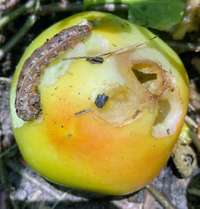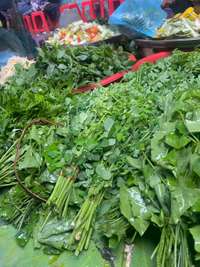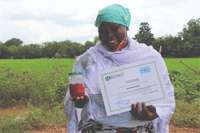ECHO often receives questions about crop selection as network members start new agricultural initiatives or enter a new area. Each agroecosystem is complex and should be evaluated for production, environmental, and socioeconomic tradeoffs as you consider the selection of a crop for cultivation, whether exotic or native. This article will focus on the initial selection of a crop for cultivation using moringa (Moringa oleifera), sweet potatoes (Ipomoea batatas), and tomato (Solanum lycopersicum) as examples.
Factors to consider
Crop use (Table 3)

Figure 4. Several sweet potato varieties prepared for cooking. Source: Emily Iverson
A crop must have a local use that meets felt needs in the community. Conduct a needs assessment before planning what crop to cultivate. Flanagan (2015) outlines options for participatory community mapping tools such as resource mapping and transect walks. Some crops may have more than one use, which may be desirable if there are several needs. People may find alternative uses for a crop than what was initially intended which should be viewed favorably and encouraged. For example, some farmers may wish to use green manure cover crops for forage instead of for soil improvement. If a crop or practice fills needs and increases sustainability and/or productivity of the agroecosystem, it should be celebrated. Remember that sustainability is a scale, not an absolute.
| Crop | Uses | Cautions |
|---|---|---|
| Moringa | Moringa leaves can be used nutritionally to boost human or animal health (Witt, 2014). Immature pods can be eaten as a cooked vegetable. Moringa seeds are consumed in some areas of the world and can be shelled, crushed, and used as a coagulant to reduce water turbidity. | Crushing moringa seeds does not remove all bacteria, viruses, or fungi (Bancessi et al., 2020); purification of water with moringa seed can be combined with the SODIS (Solar Disinfection of Water) method. The nutritional value of moringa leaf powder decreases if leaves are dried in direct sunlight (Satawase et al., 2013). |
| Sweet Potato | Sweet potato can be used nutritionally in human or animal health. Both the tubers and leaves are consumed. Improved varieties with orange flesh contain higher concentrations of beta-carotene. Leaves can be fed to livestock. | Some varieties have more palatable leaves or tubers (Figure 4) than other varieties. |
| Tomato | In subtropical and tropical settings, Roma-type tomatoes are often utilized in cooked meals. Cherry or grape tomatoes have applications for home or community gardening for fresh consumption. | Varieties differ in use and taste. You could conduct a screening trial of different varieties before selecting one for larger-scale cultivation. |
Cultivation parameters (Table 4)

Figure 5. Caterpillar damage on tomato fruit. Source: Tim Motis
Whether or not a crop will succeed depends on the cultivation requirements of the crop. This includes parameters such as rainfall, temperature, elevation, soil type and pH, management, and seasonality. Select a crop that is well-adapted to your region’s growing conditions. FAO’s ECOCROP Database of Crop Constraints and Characteristics is a valuable resource in learning about the conditions a crop can grow in. Select high yielding crops and varieties with resiliency traits such as drought tolerance or natural pest resistance. A selected crop must also fit the local farming system and be compatible with other land uses. Consider crop growth habits during selection.
| Crop | Cultivation | Cautions |
|---|---|---|
| Moringa | Moringa is drought-tolerant and can handle heavy coppicing (repeated heavy pruning). It requires very little nutrients to grow but fertilization in sandy soils increases leaf production (Motis and Reader, 2019). | Moringa does not grow well in regions that have cold seasons. Moringa does not thrive in low-lying areas where water pools. |
| Sweet Potato | Sweet potatoes can be harvested as early as three months and as late as eight months, but ideal texture and size is typically achieved in five to six months. Sweet potatoes thrive in hot, sunny conditions, with ample water. Vines crawl across the ground, but do not climb. | In areas where sweet potato weevils exist, crop rotation must be possible to control the pest. Soil type can impact tuber production. |
| Tomato | Tomatoes grow best in dry, warm seasons with irrigation supplements. Tomato plants are large and take up growing space. Some varieties, such as those with a ‘VFN’ (Verticillium, Fusarium, and Nematodes) in the name, are resistant to diseases. Cherry and grape varieties tend to be more resilient (due to heat tolerance) in tropical and subtropical settings. | Most varieties are highly susceptible to many different insect pests and diseases (Figure 5). Tomatoes require intensive management. |
Accessibility and availability (Table 5)
Select a crop that is available and accessible over time. This is especially a concern for crops multiplied using seeds. An ideal seed-propagated crop is one that will maintain desirable traits over successive seasons of planting, harvesting, and seed saving. This is more attainable with open-pollinated than hybrid varieties, as explained in an ECHO Technical Note [No. 63 (http://edn.link/tn63#opv)] by Motis (2010). If you are considering a hybrid variety, make sure seeds are available for farmers to purchase at a reasonable price. Before sharing seeds with farmers, check the germination percentage of a sample quantity. A germination test serves as an indicator of seed quality; several methods are explained in the above-mentioned ECHO Technical Note [No. 63 (http://edn.link/tn63#germ)]. If quality seed or other propagation material is too expensive or too difficult to transport, the impact of the crop may be limited due to inaccessibility. For crops that require infrastructure such as a greenhouse or fence or other inputs to grow, limited access to these materials may impact farmer adoption. Select crops that are easy to establish with minimal inputs required.
| Crop | Availability or access | Cautions |
|---|---|---|
| Moringa | Moringa can be propagated by seed or woody cuttings. It grows year-round in most subtropical and tropical climates. | Moringa oleifera does have several varieties that can cross with one another. Appropriate leaf drying conditions can be difficult in humid climates. |
| Sweet Potato | Sweet potato can be propagated by cuttings or slips (sprouts from the tuber). In the tropics sweet potatoes can be grown year-round though farmers will want to rotate production to break pest cycles. | Availability of improved varieties such as those promoted by International Institute of Tropical Agriculture (IITA) may be limited. |
| Tomato | Tomato seeds can be easily saved from year to year if the variety is open-pollinated. Tomato seeds are typically easy to find from agrodealers. | Initial acquisition of improved varieties may be difficult. Hybrid varieties require repurchasing every season. Tomatoes require extensive inputs to cultivate including fertilizer, trellising material, and a greenhouse in some situations. Farmers may not have access to these items. |
Impact on the environment (Table 6)
Look at native or naturalized4 options for cultivation before considering an exotic crop. Native and naturalized plants are already adapted to local climate and pests and are known in the community. Sometimes a plant is unknown to young people, but older generations remember its usefulness and typical growth pattern. If the genetic material has been lost, try travelling to a market further away to look for the crop. Select crops that do not have potential for weediness.
Some crops require intensive management. If the crop requires fertility inputs, plan ways to minimize negative impacts from nutrient leaching on the surrounding ecosystems, especially bodies of water. If the crop requires tillage, plan for other ways to build soil health.
| Crop | Environmental impact | Cautions |
|---|---|---|
| Moringa | Moringa is cultivated in many countries outside its native range in India (Olson, 2017), as would be expected for a crop with many uses and widely known to alleviate malnutrition. Moringa is not an agricultural weed according to assessments in Hawaii (Daehler and Denslow, n.d.) and Florida (UF/IFAS, 2022). ECHO staff 5 and others (Olson, 2017; Mashamaite et al., 2021; and Vélez-Gavilán, 2017) report that moringa has not been observed to displace native ecology/plant life. | The University of Florida describes moringa as a high invasion risk for Florida, noting its presence as a non-native in many countries (UF/IFAS, 2022). Vélez-Gavilán (2017) states that moringa is listed as invasive in some places, but concludes that information on the alleged invasiveness of moringa is conflicting and that moringa should be thought of as a widely cultivated species with low invasive potential. |
| Sweet Potato | There are most likely sweet potato varieties already growing in your region. Sweet potatoes do not typically require intensive management. | Sweet potato cultivation does require soil disturbance for harvest at a minimum. |
| Tomato | Cultivated, intentional tomato production does not have weedy potential. Pull any “volunteer” tomatoes that sprout after the season. | Tomato cultivation typically requires fertilization. To prevent nutrient runoff, utilize efficient nutrient management practices.6 |
Impact on local economy (Table 7)
A successful marketed commodity must meet demands in the local economy. It is a good idea to conduct a market analysis before planning what crop to cultivate. When there is an ample supply of a commodity in the market, the price of the item decreases. Farmers experience this most strongly during the peak of production season. When there is a shortage of a commodity in the market, the price of the item increases. Farmers can take advantage of this if they have an early-maturing crop or have found a way to extend their growing season. Select crops that produce quality products or can be processed post-harvest to create a valuable commodity.

Figure 6. Fresh moringa leaves for sale among other fresh greens at a market in Cambodia. Source: Lay Bun John
| Crop | Economic impact | Cautions |
|---|---|---|
| Moringa | The versatility in moringa’s uses makes it more likely to fit at least one niche in the local economy, either as a fresh leafy vegetable (Figure 6), dried leaf powder, edible green vegetable, or dried seeds. Leaves can be dried (in the shade) and made into powder and therefore have a longer shelf life (up to six months). | There may not be a place in the local economy for moringa. Conduct a market analysis before investing time, energy, and labor into establishment. |
| Sweet Potato | In many tropical countries sweet potato ranks close to cassava and even maize in terms of its importance as a cultivated crop (Echodu et al., 2019). Small-scale farmers value sweet potato for its high productivity with few inputs and under a range of growing constraints including drought. Sweet potato tubers are harvested both for household consumption and as a source of cash. Sugri et al. (2017) discuss postharvest methods to reduce losses and lengthen storage life, thereby improving economic return. Curing and storing sweet potatoes may allow farmers to sell them for a higher price in the off-season. |
In some regions other tubers such as cassava may be preferred over sweet potato at markets. Pests such as the sweet potato weevil (Cylas formicarius) can limit the yield potential of sweet potato if steps such as crop rotation are not taken. |
| Tomato | Tomatoes are marketable year-round in most places due to their culinary importance. To be marketable, tomatoes need to be free of blemishes or bruises. Tomatoes bruise easily when ripe. Recommendations for harvesting tomatoes are summarized in EDN 154. | Tomato prices fluctuate drastically based on seasonal supply. For this reason, ECHO’s West Africa Impact Center has conducted training on processing tomatoes into tomato paste (Figure 7). |

Figure 7. Participant of a training displays course certificate and tomato paste. Source: ECHO West Africa
Impact on society (Table 8)
Some countries have legal restrictions that prohibit or discourage the cultivation of certain crops. Review local limitations before cultivating a crop to verify that it is free of legal restrictions. Consider how a crop might impact labor dynamics. For example, a crop may need additional weeding or processing which may overburden one gender or age group over another if roles are already divided. A crop must fit local culinary preferences to be accepted.
| Crop | Societal impact | Cautions |
|---|---|---|
| Moringa | Moringa may have traditional uses in local contexts. Shucking, drying, and pounding moringa leaves to make powder can be tedious work. | Moringa, though nutritious, is bitter. If bitter foods are not common in local culinary preferences, be sensitive to this. |
| Sweet Potato | If seeking improved varieties, contact local extension services to see what plant resources may be available. If you are planning on importing varieties from outside the country, make sure to contact the country agriculture department first. | Sweet potatoes may not be the desired tuber or starch in the local community. Some cultures are used to one color of sweet potato and may not be open to varieties of a different color. |
| Tomato | Tomatoes are a very intensive crop to grow, requiring fertilization, irrigation, pest management, removal of suckers, trellising, and weeding. Think about labor divisions and how that might impact the workload of farming families. | If tomatoes are not typically eaten fresh, do not push the consumption of fresh tomatoes. |
Closing Thoughts
Overall, ECHO encourages the cultivation of crops that are low-risk. All the considerations mentioned in this article help guide crop selection that has minimal risk to local production, environmental, and socioeconomic outcomes while attempting to fill a felt need in the community. Additionally, selecting crops utilizing these parameters encourages acceptance of the crop. For wide acceptance of a crop to be achieved, many of these considerations must be met. If you are thinking of introducing a new crop to your region, ECHO staff and network members share additional ideas and cautions in ECHO Technical Notes Introducing New Seeds and Introducing a New Fruit Crop.
References
Bancessi, A., M.M.F. Pinto, E. Duarte, L. Catarino, and T. Nazareth. 2020. The antimicrobial properties of Moringa oleifera Lam. for water treatment: a systematic review. Springer Nature Applied Sciences 323 (2020).
Daehler, C. and J. Denslow. n.d.. Weed risk assessments for Hawaii and Pacific Islands. http://www.botany.hawaii.edu/faculty/daehler/wra/full_table.asp.html (accessed 19 August 2022).
Echodu, R., H. Edema, G. Wokorach, C. Zawedde, G. Otim, N. Luambano, E.M. Ateka, and T. Asiimwe. 2019. Farmers’ practices and ther knowledge of biotic constraints to sweetpotato production in East Africa. Physiological and Molecular Plant Pathology 105:3-16.
Flanagan, B. 2015. Participatory Methods and Tools in Community Development. ECHO Summary of MEAS Participatory Methods documents.
Mashamaite, C.V. P.N. Mothapo, P.J. Pieterse, and E.E. Phiri. 2021. The impact of Moringa oleifera on the composition and diversity of invertebrate species, with a focus on ants as an indicator group. Acta Horticulturae 1306:107-114.
Motis, T.N. and S.M. Reader. 2019. Moringa oleifera leaf production with NPK fertilizer and composted yard waste. Acta Horticulturae 1253:405-412.
Olson, M.E. 2017. Moringa frequently asked questions. Acta Horticulturae 1158:19-32.
Satawase, A.N., G.R. Pandhre, P.G. Sirsat and Y.R. Wade. 2013. Studies on drying characteristic and nutritional composition of drumstick leaves by using sun, shadow, cabinet and oven drying methods. Open Access Scientific Reports 2(1).
Sugri, I., B.K. Maalekuu, F.Kusi, and E. Gaveh. 2017. Quality and shelf-life of sweet potato as influenced by storage and postharvest treatments. Trends in Horticultural Research 7:1-10.
UF/IFAS (University of Florida/Institute of Food and Agriculutral Sciences). 2022. Assessment of non-native plants in Florida’s natural areas: Moringa oleifera. https://assessment.ifas.ufl.edu/assessments/moringa-oleifera/ (accessed 19 August 2022).
Vélez-Gavilán J, 2017. Moringa oleifera (horse radish tree). Invasive Species Compendium. Wallingford, UK: CABI. DOI:10.1079/ISC.34868.20203483184
Witt, K. 2014. The Nutrient Content of Moringa oleifera Leaves. ECHO Research Notes 1:1.